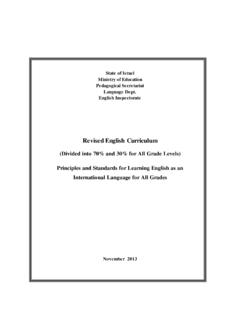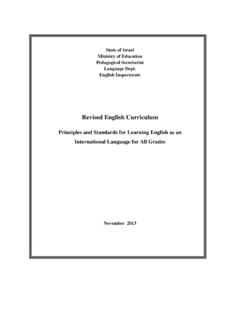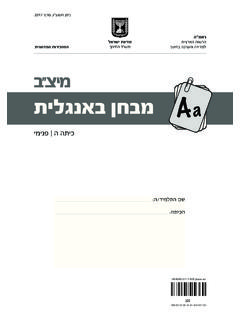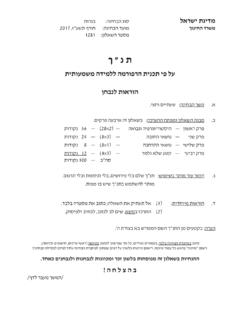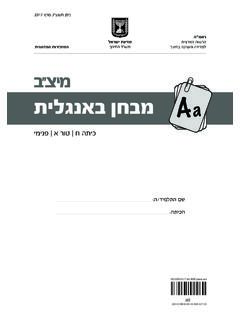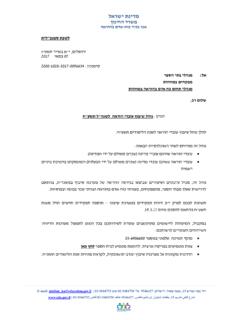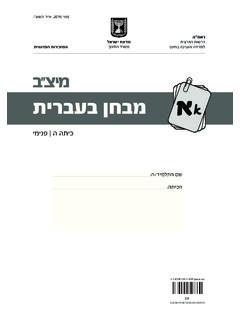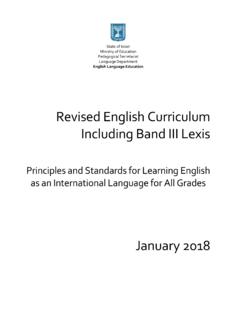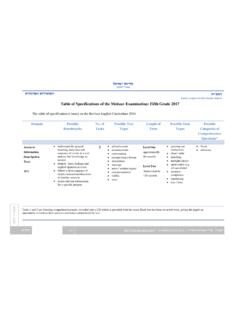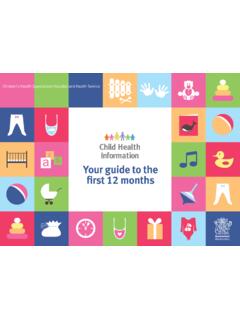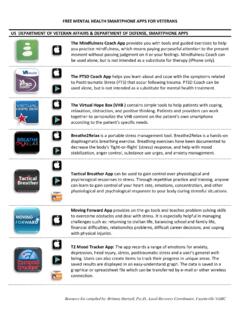Transcription of A PRACTICAL GUIDE FOR TEACHING VOCABULARY
1 A PRACTICAL GUIDE FOR TEACHING VOCABULARY Written by: Prof. Penny Ur, Head of Writing Committee Dr. Orly Haim Dr. Miriam Kluska Dr. Shoshana Plavin Jaye Shlayer Dr. Judy Steiner, Dr. Lynn Timna August, 2014 Updated August 2018 A PRACTICAL GUIDE FOR TEACHING VOCABULARY 2 CONTENTS A. Information: Frequently asked questions and answers - The VOCABULARY component in the Curriculum, and the ways it will affect your TEACHING .. 3 B. Implementing the VOCABULARY component in the classroom - (How can we find the time?) General guidelines and strategies to improve VOCABULARY TEACHING and learning, with lots of PRACTICAL 5 C. More ideas 1: VOCABULARY expansion - PRACTICAL ideas for expanding students VOCABULARY at all levels.. 10 D. More ideas 2: presenting new VOCABULARY - Ways of presenting the form and meaning of new items.. 13 E. More IDEAS 3: VOCABULARY review - Activities that get students to repeat and review VOCABULARY without getting bored.
2 15 F. More ideas 4: Advanced VOCABULARY activities .. 25 G. VOCABULARY Assessment - Some useful ways of testing VOCABULARY .. 28 H. Useful resources - Recommended Internet sites that provide VOCABULARY work (with notes telling you what they consist of), useful books, and interesting research.. 34 A PRACTICAL GUIDE FOR TEACHING VOCABULARY 3 A. INFORMATION: FREQUENTLY ASKED QUESTIONS AND ANSWERS - THE VOCABULARY COMPONENT IN THE CURRICULUM, AND THE WAYS IT WILL AFFECT YOUR TEACHING . WHY IS THERE A SECTION ON VOCABULARY TEACHING IN THE CURRICULUM? Four main reasons: Teachers and textbook writers have been saying for years that we need VOCABULARY and grammar lists to help achieve the benchmarks; VOCABULARY is the most important component of language knowledge; it is one of the best predictors of language performance; Many students get to twelfth grade with a relatively small VOCABULARY , which prevents them from achieving their potential (based on research done in Israel and abroad, Schmitt, 2008; Laufer).
3 Students don t just pick up VOCABULARY from reading and listening. It needs to be actively taught (see PRACTICAL suggestions later in this booklet). WHAT DOES THE VOCABULARY SECTION OF THE CURRICULUM INCLUDE? Two main requirements: Core VOCABULARY lists of essential items for Foundation and Intermediate levels, of about 700 items each; a core VOCABULARY list of essential items for Proficiency level of about 1400 items1. The number of VOCABULARY items students are expected to learn at each level, (items from the Core lists, plus other items chosen by textbook writers and teachers). These numbers are: about 1200 for Foundation, an additional 2000 at Intermediate, and another 2200 at Proficiency: about 5400 in all. 1 This looks like a lot:but it includes many items which will have been taught in earlier years as part of the expansion VOCABULARY . A PRACTICAL GUIDE FOR TEACHING VOCABULARY 4 HOW DOES THIS AFFECT MY TEACHING OF VOCABULARY ?
4 You ll need to spend quite a lot of lesson time on TEACHING new VOCABULARY and reviewing it throughout the year. This means probably about one-third of lesson time, on average, will be devoted to VOCABULARY work (there are lots of PRACTICAL ideas in this booklet to help you do this). Also, you ll need to take more care in selecting which items to teach: select the items you feel will be most useful to your students; include multi-word items (lexical chunks) like in any case. HOW MANY NEW VOCABULARY ITEMS SHOULD I TEACH IN A LESSON? In principle, about 12 new items a week in elementary school, about 20 in junior high, about 30 in high school. This will vary of course, according to the individual class: lower hakbatzot will learn fewer, classes of native speakers can be expected to learn more. Remember you ll need to set aside time also for review! HOW MUCH REVIEW DO I NEED TO DO? In order to make sure that students have mastered the items, they need to review them at least ten times, probably more!
5 Obviously, you can t review every item ten times, but you should make sure you do so several times. So this means that you ll need to review new items you ve taught not only at the end of the same lesson or unit, but will need to come back to them regularly over the whole year (see Myth 5 below) A PRACTICAL GUIDE FOR TEACHING VOCABULARY 5 B. IMPLEMENTING THE VOCABULARY COMPONENT IN THE CLASSROOM - (HOW CAN WE FIND THE TIME?) GENERAL GUIDELINES AND STRATEGIES TO IMPROVE VOCABULARY TEACHING AND LEARNING, WITH LOTS OF PRACTICAL IDEAS. REORGANIZATION It s not a question of adding, it s a question of reorganization. Two things you might cut down to make room for VOCABULARY work: Grammar. There is a tendency to devote too much time to grammar TEACHING , much of which should be transferred to VOCABULARY . Checking homework. Often half the lesson is wasted on going through exercises students have done for homework. Try .. just giving the answers, or writing them up on the board; students self-check and then respond only if there is a problem; giving them five minutes to check through the answers in pairs, asking you only if there is a problem; taking in their homework to check at home (obviously you can t do this every time, too time-consuming, but occasionally you can, and it saves time in class).
6 A PRACTICAL GUIDE FOR TEACHING VOCABULARY 6 MYTHS There are some assumptions that lead us to teach VOCABULARY not very efficiently, and which are not in fact true. Let s look at some of these. MYTH #1: YOU SHOULDN T TRANSLATE NEW WORDS INTO L1. Not true. You may. Use other means as well - pictures, mime, explanations, examples but don t feel guilty about clarifying by means of the L1. And of course, later review should be mainly in English: but for the first time you explain a word, L1 can be really helpful . MYTH #2: IT S MORE IMPORTANT TO TEACH READING STRATEGIES THAN VOCABULARY . Not true. Reading strategies are no substitute for knowing VOCABULARY . Learning how to skim, scan, infer from context etc., is of surprisingly limited value in reading comprehension when students don t know enough VOCABULARY . So it s not worth spending too much time practicing reading strategies: make students aware of them, certainly, but it ll be much more helpful to them if you spend most of your time TEACHING and reviewing VOCABULARY .
7 MYTH #3 VOCABULARY SHOULD ALWAYS BE TAUGHT AND REVIEWED IN (SENTENCE OR LONGER) CONTEXT. Not always. There s a place for TEACHING and review of single items on their own. And often putting a new word into a brief phrase is just as helpful as putting it into a full sentence. Both these, of course, are much quicker than full-context activities. Bottom line: VOCABULARY should be taught both within contexts and as single, decontextualized, items. A PRACTICAL GUIDE FOR TEACHING VOCABULARY 7 MYTH #4: STUDENTS CAN ALWAYS GUESS MEANINGS FROM CONTEXT. Not true. They usually can t. Not just because they re untrained, and not just because the texts are too difficult, but simply because research shows that even educated native speakers often can t guess a word from context correctly: the context doesn t give enough clues to meaning. Only in the minority of cases does the surrounding context make the meaning of an unknown word clear. So don t waste time pushing students to infer words in class: just tell them what they mean.
8 (That doesn t mean that inferring from context is useless students will use it in their own independent reading only that it s not a very efficient way to teach new words in class). MYTH #5: IT S ENOUGH TO EXPOSE A LEARNER THREE OR FOUR TIMES TO A NEW WORD FOR THEM TO LEARN IT. Not true. This isn t enough. According to research, a learner will only master a new item if he or she gets ten or more opportunities to review (some say as much as 20). So it s important to review new items you taught at the end of the same lesson, and again in the next lesson; but then remember that you ll need to come back to them after a week, and again later. Of course you won t have time to review every single item ten or more times, but remind students to refresh their memories every now and then (see Strategies below). MYTH #6: WHEN READING A NEW TEXT, STUDENTS CAN ALWAYS LOOK NEW WORDS UP IN A DICTIONARY, SO THEY DON T NEED TO LEARN SO MANY IN ADVANCE.
9 Not true. Looking up in a dictionary is time-consuming and often results in mistakes. And there s research to show that students who use dictionaries for reading comprehension understand no better than those who don t! There is no substitute for knowing lots of VOCABULARY . (Incidentally, the more VOCABULARY students know, the more likely they are to use dictionaries successfully when needed.) A PRACTICAL GUIDE FOR TEACHING VOCABULARY 8 STRATEGIES AND PRACTICAL IDEAS Here are some useful strategies for TEACHING VOCABULARY without adding extra work and time, together with PRACTICAL ideas that use them. STRATEGY 1: MAKE STUDENTS RESPONSIBLE. Share with students why they need to learn a lot of VOCABULARY : it s probably the most important aspect of language that they need to know. Tell students that they ll need to work on VOCABULARY expansion themselves outside the lessons: there s simply no time during lessons to teach them all the VOCABULARY they need and review it.
10 There are some ideas in the next section about ways students can expand their own VOCABULARY . Tell students to keep VOCABULARY / dictionary notebooks (could be on smartphones or tablets) to keep a record of new VOCABULARY learnt. Give students five minutes during class to check through their VOCABULARY lists or notebooks and remind themselves of things they ve learnt. Make opportunities for students to share their personal strategies for learning and reviewing new VOCABULARY . STRATEGY 2: USE QUICK, FIVE-MINUTE VOCABULARY ACTIVITIES EVERY LESSON. Ask students to call out all the items they ve learnt in the last two weeks, write them up as fast as you can. Add any they ve forgotten. Challenge students in groups to recall as many items as they can: who can remember most? Have the items on the board at the beginning of the lesson; ask students to scan them, say if there are any whose meaning they don t remember; tell them.
